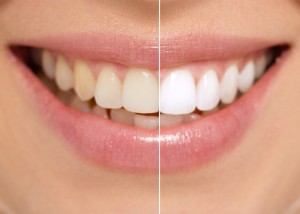Teeth Whitening
 The natural color of teeth is not white. They are typically a shade of either yellow or gray and tooth color varies from person to person.The procedure to whiten teeth is fairly simple but there are some rules that need to be followed to achieve and maintain good results.
The natural color of teeth is not white. They are typically a shade of either yellow or gray and tooth color varies from person to person.The procedure to whiten teeth is fairly simple but there are some rules that need to be followed to achieve and maintain good results.
- Why teeth get discolored
- How to whiten teeth
- In office whitening
- At home whitening
- How long will whitening last
- What are the side effects
- Is everyone a candidate for whitening?
Why Teeth Get Discolored
There are many reasons why teeth can become discolored. The major reasons are:
- Diet – Drinking tea, coffee, red wine or other food and drink with strong colorings
- Smoking – Smoking can result in teeth appearing a yellowish color
- Age – As people grow older their teeth can become darker naturally
- Tooth decay, fillings and tartar build-up can cause discoloration
- Trauma – Teeth have nerves and blood vessels inside them. If these nerves and blood vessels are damaged the tooth may become darker – even several years after the trauma.
- Medication – Staining can be caused by diseases or medicines. Tetracycline, an antibiotic, will cause a distinct discoloration if given to a child whose adult teeth are still developing.
How to Whiten Teeth
 There are many simple ways to improve the appearance of discolored teeth:
There are many simple ways to improve the appearance of discolored teeth:
- Regular cleaning to remove the plaque and tartar.
- Regular tooth brushing
- Stop smoking
- Reducing the intake of food and drink that are strongly colored such as coffee, tea, red wine, etc.
- Professional whitening
Whitening toothpastes claim to whiten teeth, but they do so at an expense. They vary from slightly abrasive to very abrasive. They may appear to make your teeth whiter by removing stains, but some are abrasive enough to remove enamel, which makes these toothpastes a very poor long-term solution.
Back to top
In-Office Whitening
There are a few different methods for whitening your teeth in the office. We can whiten them from the outside-in or the inside-out. The inside-out method, which is known as internal bleaching, is only an option for teeth that have previously had root canal treatment.
External Whitening
This means that the color of the teeth is lightened by placing a whitening solution on the outside of the teeth. This is also known as “laser” or “power” whitening. We will put a rubber seal around your teeth to protect your gums. Then, the whitening gel is painted onto your teeth and a special, bright light is pointed at them. This light speeds up the whitening process. The procedure takes one to two hours.
Internal Whitening
As stated above, this is only an option for teeth that have had root canal treatment. The gums are isolated from the teeth and an opening is made from the back side of the tooth. A strong whitening solution is placed on a cotton pellet and then the opening is temporarily sealed. This is left for about a week and then the color is checked. The tooth will usually take two or three visits to whiten in this manner.
At-Home Whitening
This method requires an impression to be made of your mouth so that a custom tray, which holds the whitening gel against your teeth, can be made. The gel is typically worn for a few hours a day for a period of one to three weeks.
How long will whitening last?
Since the results vary from patient to patient there is no firm answer. We do know that teeth tend to become darker as time passes, so touch-up treatments are occasionally needed to keep the teeth lightened. Your eating, drinking, smoking and home care habits definitely have an effect on how long the treatment lasts. Remember that the base shade of teeth is yellow or white and that we cannot whiten this base color. However, most patients are very satisfied with the results of whitening treatments.
What are the side effects?
Some patients report a temporary increase in sensitivity. Tender gums are also a known side effect especially if you are whitening at home and use too much of the whitening solution. Remember that a little is good, and a lot will not make your teeth any whiter.
Is everyone a candidate for whitening?
NO! There is no whitening solution for most dental work such as fillings, crowns, veneers, or partial or full dentures. If the color of your teeth matches the color of your dental work before whitening, the color of your teeth will most likely be different from the color of your dental work after whitening. You are making a commitment to replacing those restorations if you whiten your teeth. We typically wait a few weeks after any whitening treatment to replace these restorations since we want to match the new color and we want the color to stabilize before choosing a color for the new restorations.
Your gums must also be healthy and any decay must be treated since both of these can be a cause of sensitivity during whitening treatments.
Teeth whitening is not recommended for children whose teeth are still developing or for women who are pregnant or breastfeeding.


